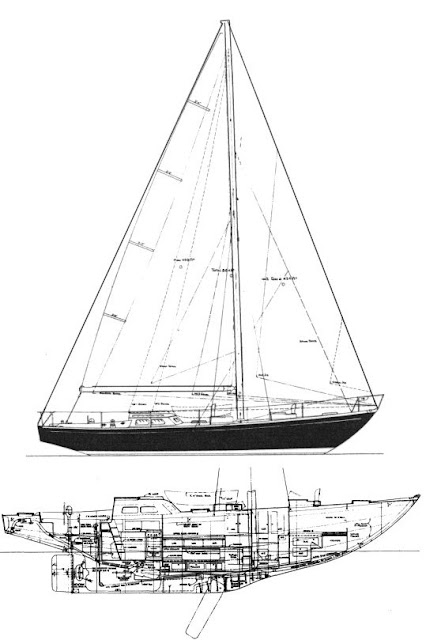 |
| Dancer is a Tripp-designed, 55-foot flush deck aluminum cutter built in 1965 by Abeking & Rasmussen. |
In the last two decades of the Cruising Club of America (CCA) rating rule, William H. Tripp Jr. became known for winning and weatherly sailboats, including the Columbia 43.
He also designed, what many sailors and yacht designers consider, some of the most beautiful boats ever built in fiberglass. They continue to captivate sailors and command high prices in the used boat market today. In 2014 Cruising World Magazine's readers and editors chose Tripp's Columbia 50 and Hinkley Bermuda 40 as two of the "40 Best Sailboats Ever Made."
 |
| The Hinkley Bermuda 40, designed by Tripp, had the longest production run in U.S. history. She is as seaworthy as she is beautiful. |
His designs were informed by many years of racing Star-class sailboats and other sailboats while growing up. The seaworthiness of his designs owes something to his experience serving in the Coast Guard during World War II. Trip was assigned to the Offshore Patrol out of Greenport, Long Island.
"This very special branch of the service created some enduring legends ...with its all-weather, all-season operations on the lookout for subs approaching our shores in the early days of the war," wrote Bill Robinson in The Great American Yacht Designers.* "With conventional antisubmarine vessels in short supply, sailing yachts were used as lookout posts.... There was no better school for finding out how the hull of a sailing vessel acts in a sea, and Bill found the firsthand encounter a valuable experience."
 |
| The Mercer 44 is one of Tripp's most enduring classics even though only 14 were built. |
Tripp was a prolific designer. In addition to providing custom racing and cruising designs for many clients, he designed production boats for Seafarer, Hinckley, Pearson, Columbia and others. An early advocate of fiberglass, he became known for flush-deck race boats with his distinctive gun-turret dog houses.
As a teenager in the 1960s, Seattle-based yacht designer Bob Perry considered Tripp his favorite designer. "Tripp’s boats had a very distinctive look, with proud sweeping spoon bows, bold sheer springs, long concave counters terminating in almost vertical transoms, and sexy and svelte cabin trunks," Perry wrote in the November/December 2011 issue of Good Old Boat Magazine.** "You would never mistake a Tripp design for an S&S design. They just seemed to my young eye to have a strength and boldness, kind of an 'in your face' quality. Plus, his boats were consistent race winners."
Burgoo, the Tripp-designed Pearson 37-foot Invicta centerboard yawl, won the Bermuda race in 1964. At that time it was the smallest fiberglass boat to ever win the race. "[I]t had all the Tripp trademark design features and it was a very sexy-looking little boat," Perry wrote. "In fact, and I could be wrong, this may be the first Tripp design to have the “gun turret” cabin trunk."
 |
| Ondine, a 57-foot aluminum yawl designed by Tripp, is arguably the most successful racing yacht in history. |
"Bill was the first to put portlights in the topsides as well as opening ports in cockpit sides to improve air circulation and communication below," said Ted Jones,*** who worked with Tripp before becoming a boating magazine editor. "He popularized flush decks on small boats (Galaxy, Medalist, Invicta, Mercer 44), and set high standards in hull and rigging scantlings that have been proven over time. He designed boats to stay together under the most difficult circumstances. I cannot recall one of his designs ever being dismasted or suffering structural damage at sea."
 |
| Columbia President Dick Valdes and designer Bill Tripp look at plans circa 1965. |
In the next six years, he produced thirteen Columbia yachts, including the Columbia 26 MkII, Columbia 34, Columbia 39, Columbia 43, Columbia 45, Columbia 50, and the Columbia 57. The boats are vintage Tripp, but with the innovation of fin keels and spade rudders.
The C-50 attracted a strong following and still has an active owners association. For years they raced as a one-design class in California, in addition to racing in handicap events. "The Columbia 50 was a big elegant-looking boat with the same bubble house and long flush deck (of many other Tripp designs)," Perry wrote. "It was a very good-looking boat and it was fast. Seattle’s racing scene was dominated for years by a Columbia 50 called Six Pack while the smallest class was dominated by a Columbia 26 called Miller’s High Life."
 |
| Grundoon, a Columbia 50, in the 2012 Newport-Bermuda Race. |
 |
| Encore, a Columbia 43, on her way to winning her class in Transpac. She was eighth overall in the fleet that year. |
The design also dominated other big yacht races, like in the Ocean Racing Class of the Newport to Ensenada Yacht Race. In 1970 it was the world's largest ocean race at the time with 539 boats competing. Blue Norther, Columbia 43 hull number seven, was the overall winner.
Tripp's legacy endures in his beautiful boats - many of which are still sailing today. His son, William H. Tripp, III is also a yacht designer with many large and beautiful yachts to his credit, including an update of his dad's famous Bermuda 40. Hinkley commissioned Tripp III to design the Bermuda 50, which was launched in 2015.
 |
| The newest Hinkley sailboat is the Bermuda 50 designed by Bill Tripp III. |
*The Great American Yacht Designers by Bill Robinson, Alfred A. Knopf, 1974
**The Legacy of Bill Tripp By Robert Perry, Good Old Boat Magazine, November/December 2011 pages 14-17
*** Bill Tripp's Boats by Ted Jones, Professional BoatBuilder, February/March 2007, pages 56 - 77